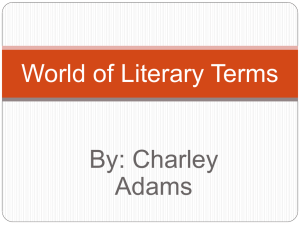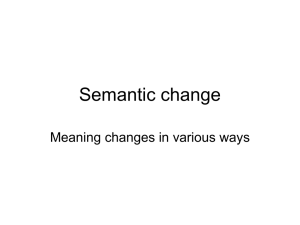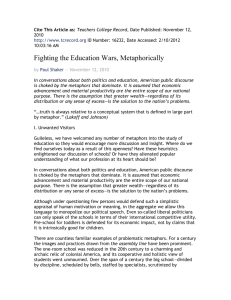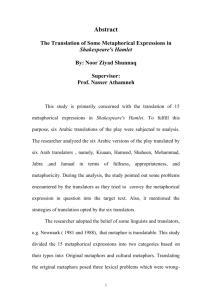Can I contribute to the metalude web-site?
advertisement
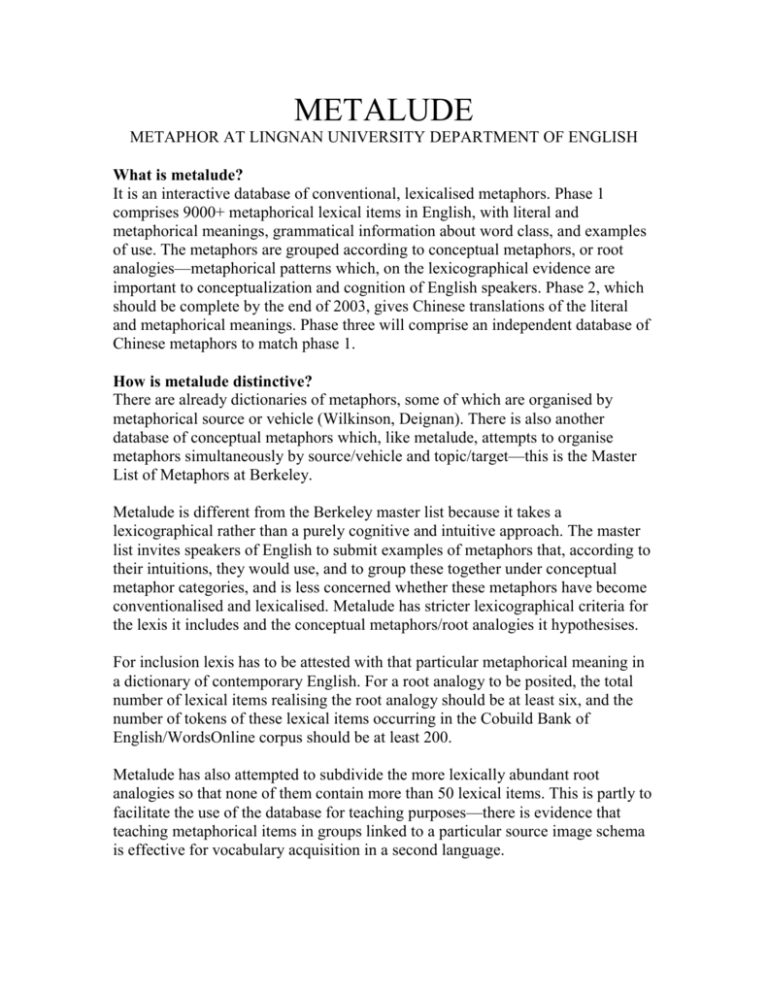
METALUDE METAPHOR AT LINGNAN UNIVERSITY DEPARTMENT OF ENGLISH What is metalude? It is an interactive database of conventional, lexicalised metaphors. Phase 1 comprises 9000+ metaphorical lexical items in English, with literal and metaphorical meanings, grammatical information about word class, and examples of use. The metaphors are grouped according to conceptual metaphors, or root analogies—metaphorical patterns which, on the lexicographical evidence are important to conceptualization and cognition of English speakers. Phase 2, which should be complete by the end of 2003, gives Chinese translations of the literal and metaphorical meanings. Phase three will comprise an independent database of Chinese metaphors to match phase 1. How is metalude distinctive? There are already dictionaries of metaphors, some of which are organised by metaphorical source or vehicle (Wilkinson, Deignan). There is also another database of conceptual metaphors which, like metalude, attempts to organise metaphors simultaneously by source/vehicle and topic/target—this is the Master List of Metaphors at Berkeley. Metalude is different from the Berkeley master list because it takes a lexicographical rather than a purely cognitive and intuitive approach. The master list invites speakers of English to submit examples of metaphors that, according to their intuitions, they would use, and to group these together under conceptual metaphor categories, and is less concerned whether these metaphors have become conventionalised and lexicalised. Metalude has stricter lexicographical criteria for the lexis it includes and the conceptual metaphors/root analogies it hypothesises. For inclusion lexis has to be attested with that particular metaphorical meaning in a dictionary of contemporary English. For a root analogy to be posited, the total number of lexical items realising the root analogy should be at least six, and the number of tokens of these lexical items occurring in the Cobuild Bank of English/WordsOnline corpus should be at least 200. Metalude has also attempted to subdivide the more lexically abundant root analogies so that none of them contain more than 50 lexical items. This is partly to facilitate the use of the database for teaching purposes—there is evidence that teaching metaphorical items in groups linked to a particular source image schema is effective for vocabulary acquisition in a second language. A further difference from the master list is in the nature of the metaphorical target or topic. Within the Lakoff tradition, from which the master list springs, the emphasis has been upon concretising metaphors, i.e. metaphors whose target is abstract and whose source is relatively concrete. The term “conceptual metaphor” suggests that these are metaphors for abstract concepts. By contrast metalude also includes root analogies whose topics/targets and vehicles/sources are at the same level of abstraction, such as HUMAN IS ANIMAL. How can I use this website? The English database can be searched by lexical item, or by root analogy. If you sort by lexical item you will find all the metaphorical meanings that the database recognises for this lexical item, and the root analogies which they belong to, e.g. X. If you search by root analogy you will find all the lexical items that the database lists under that root analogy e.g. X. One guide to the overall shape of the database is the Map of Root Analogies, which has 6 columns representing the different categories of Topics and 4 columns representing the different categories of Vehicles. The Topic categories are (1) Values, Quantities and Qualities, (2) Emotions, Experiences and Relationships, (3) Thinking and Speaking, (4) Activity and Movement, (5) Humans, Humans Senses and Society and (6) Things and Substances. The Vehicle categories are (A) Things and Substances (Objects, plants, Substances, Money, Liquid, Food), (B) Human Body, Animals and Senses, (C) Activity and Movement and (D) Place and Space. One can search for particular root analogies by finding the relevant co-ordinates on the map, for example anything ACTIVITY IS PLACE and related root analogies would have the co-ordinate 4D. Related to this Map is a List of Root Analogies which can either be sorted by Source or Target. It also gives a map co-ordinate reference for each root analogy. Can I contribute to the metalude web-site? Yes you can. To the making of dictionaries and words there is no end. The metalude database does not claim to be anything like complete, whatever that would mean in lexicographical terms. And successful lexicographical enterprises like the OED are all a matter of teamwork. The database is, for example, probably quite light on slang or colloquial metaphor from anywhere but the UK. However, there is a procedure for submitting your suggestions, so that you must provide a dictionary source for your lexis. You should also, of course, check carefully against the existing database to see that the item with that meaning is not already included. Please see the suggestions page. Suggestions for new root analogies (or reinterpreting of existing data under different root analogies) is a more complicated matter. You must find at least 6 lexical items, and these should be checked against Collins WordsOnline (formerly the Bank of English) database to give at least 200 tokens of their use—we may be able to do the latter for you. How do I register for access to the metalude database? While wish the data to be in the public domain, the information on this database is copyright and should not be used unscrupulously without due acknowledgements, or for commercial purposes without permission. We have provided a simple form which you can download, which asks you to sign a copyright declaration and fax it to the English Department of Lingnan University. You will then be issued a password by e-mail. Who made metalude? This database has been compiled mainly by Andrew Goatly, beginning in 1992. Since 1999, however, he obtained funding from the Research Grants Committee of the Hong Kong SAR government for a project entitled ‘A Comparison of the metaphorical structure of the English and Chinese lexicons (Grant no: ) of which he was the principal investigator. During this project he had help from the following: Alison Chong, Cynthia Mok, Liz Chow, Ming X, Diane Nicholls, Julia Goatly, and his co-investigator Ersu Ding. The web-site was set up by Vesta Lee and Crystal Yuen. Where did the data come from? The English data came from the following dictionaries: Collins COBUILD English Dictionary, Cambridge International Dictionary of English, and to a lesser extent The Encarta Dictionary, and The Oxford English Dictionary. Other invaluable reference books were Collins Cobuild English Guides vol.7: metaphor by Alice Deignan, and A Thesaurus of Traditional English Metaphors by P.R. Wilkinson (Routledge 2002). The BBC World Service and newspapers in general were other important sources. Other data was culled from the literature on conceptual metaphors, especially ideas for the important English conceptual metaphors: Goatly, A. (1997) The Language of Metaphors London: Routledge, Johnson, M. (1987) The Body in the Mind. London: University of Chicago Press, Lakoff, G. (1987) Women, Fire and Dangerous Things Chicago: University of Chicago Press, Lakoff, G, Johnson, M (1980) Metaphors We Live By Chicago: University of Chicago Press, Lakoff, G, Johnson, M (1999) Philosophy in the Flesh New York: Basic Books, Lakoff, G and Turner, M (1989) More than Cool Reason: A Field Guide to Poetic Metaphor Chicago: University of Chicago Press, Sweetser, E. (1990) From Etymology to Pragmatics: Metaphorical and Cultural Aspects of Semantic Structure Cambridge: CUP. The English Database When searching the database you will find that the same lexical item with the same metaphorical meaning may be listed more than once. This is because it seems to belong to more than one root analogy. Take for example the word head meaning ‘leader, someone in charge of an organisation or group’, which can be seen as belonging to either HUMAN IS BODY-PART, ORGANISATION PART IS BODY PART and IMPORTANCE/STATUS IS HIGH. This kind of ambiguity is different from the ambiguity of lexical items with the same literal meaning but a different metaphorical meaning which places them in a different root analogy. For instance disgorge means literally ‘empty out the liquid contents’, and metaphorically means both ‘empty out large numbers of people’ in the root analogy CROWD/HUMANS IS LIQUID, and ‘provide money’ in the root analogy MONEY IS LIQUID/BLOOD. Understanding the data here is generally quite straightforward, but the typographical conventions for literal meaning and part of speech need explanation. Metaphors can be hidden or buried in lexis, by a number of word-formation processes such as conversion (change of part of speech without change of form), or compounding—containing the metaphorical item within larger structures such as phrasal verbs or word-compounds or idioms. In cases of conversion and compounding the literal lexical item entry with be in parentheses. In the case of compounding usually only the relevant metaphorical part of the compound will be given its literal meaning inside the parentheses, and the literal meanings for the rest of the compound with be represented by ____. For example ACHIEVEMENT/SUCCESS IS HIGH hang in there (be suspended__) idi(vi+adv+adv) ‘avoid failure despite difficulties’ when the marathon gets tough just hang in there ACTIVITY IS BOAT TRAVEL anchorman (heavy, metal, cross-shaped object used to stop ships moving__) n ‘presenter of a radio or television broadcast’ The early morning news programme has a new anchorman As the words in there and man are not considered part of the metaphorical schema, only the hang and anchor are translated within the parenthesis. In cases where all the words in the compound or idiom have metaphorical meanings consistent with the same schema, but where the phrase is seldom or never used literally, the literal meaning too may be put in parentheses, but this time with no blanks e.g. ACTIVITY IS BOAT TRAVEL stick/put your oar in (push or put your paddle into) idi(vt+nphr+adv) ‘interrupt annoyingly’ he kept on putting his oar in until I lost my temper For conversions there should also be two entries under the part of speech, separated by a bar, the one in parentheses corresponding to the part of speech when used literally and the later one outside parentheses to the part of speech when used metaphorically e.g.. ACTIVITY IS BOAT TRAVEL harbour (port for a ship) (n)|vt ‘protect by giving a hiding place to’ the Taleban were accused of harbouring Osama Bin Laden HUMAN IS BUILDING derelict in bad condition, partly ruined (adj)|n ‘homeless, jobless person’ the derelicts on the streets need extra help The part of Speech information for idioms and what might loosely be called phrasal verbs is rather complex. Here are some examples to make the distinctions clear: 1. go around vi+adv the rumour is going around that Lady Diana was pregnant 2. leap out at vi+adv+pr the hatred of Jews in Pound's poems leaps out at you 3. play with vi+pr he offered me the headship and then withdrew the offer-was he playing with me? 4. dip…into vt+… +pr she dipped a hand into the jar of sweets and pulled one out 5. string…along vt+…+adv he strung me along for months about repaying that loan 6. knock together vt+adv I could knock together a short article for you in a couple of hours The first three verb types are intransitive because none of them has a direct object. However, 2 and 3 could be thought to have an indirect object since the preposition at the end of them is followed by a noun. 4 has both a direct object and a kind of indirect object following the preposition. 5 has a direct object but is followed by an adverb (therefore has no indirect object). Type 6 differs from type 5 in that the word order is optional—‘I could knock a short article together for you’ is just as acceptable’ and in cases of a pronoun as object this latter word order is obligatory. This is why it is classified as a transitive verb. Often there are subtle variations in sub-categorisation of word-class from literal to metaphorical meanings. Abbreviations for parts of speech: adj adjective adv adverb advphr adverbial phrase art article cl clause excl exclamation idi idiom n noun nplur plural noun nphr noun phrase pr pref prphr pt v verg vi virec vref vt preposition prefix prepositional phrase particle verb ergative verb intransitive verb reciprocal verb reflexive verb transitive verb



